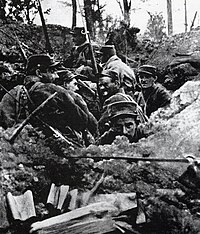Portuguese Armed Forces
This article needs to be updated. |
{{country data {{{1}}} | Military/core | variant = | size = | name = }}
The armed forces of Portugal, commonly known as the Portuguese Armed Forces (Forças Armadas Portuguesas), encompasses a Navy, Army and an Air Force. The President of Portugal is the formal Supreme Commander of the Defence Forces, but in practice they answer to the Portuguese Government via the Minister of Defence.
History
The history of the Portuguese Armed Forces is directly connected to the history of Portugal.
Origins
The land and naval forces fought for Portuguese independence against the Leonese and the Moors in the 12th century, against the Castilian invaders in the 14th century, against the Spanish occupiers in the 17th century and against French invaders in the 19th century.
World War I

More than a year after the war in Europe broke out, the government of Portugal orders the arrest of German ships anchored in Portuguese ports following a British request, leading to a war declaration by Germany. An army corps with the name Portuguese Expeditionary Corps (Corpo Expedicionário Português, CEP) is formed at Tancos, made of 30,000 soldiers, under command of general Norton de Matos. It is decided to include CEP into the British Expeditionary Force (BEF) and the first men arrive in France by February 1917. Also an artillery Portuguese corps is sent to man French batteries which they start operating by March 1918.
The CEP would see major action at Battle of La Lys, as it became known in Portugal, or Operation Georgette, or Battle of Estaires to the British. The Portuguese 2nd division is overhelmed by the superior numbers of the German army and the unit is almost completely lost. The war would end in the same year with the allied victory. Portuguese troops also fought in Africa, due to the colonies of Angola and Mozambique bordering German territories.
Recent History
Since 2003, the military service is optional. Portugal has military involved in several peacekeeping missions abroad, like INTERFET and UNTAET in East-Timor, MINURSO in Western Sahara, EUFOR in Bosnia and KFOR in Kosovo.
The last government spent large amounts of money in the modernization of the Armed Forces, in an action that created much controversy, the main one was the acquisition of 2 new submarines.
Rank
| Class | Navy (Marinha, Armada) |
Army/Air Force (Exército/Força Aérea) |
|---|---|---|
| Honorific | Almirante da Armada | Marechal |
| General Officers (Oficiais Generais) |
Almirante | General |
| Vice-Almirante | Tenente-General | |
| Contra-Almirante | Major-General | |
| Comodoro | Brigadeiro-General | |
| Senior Officers (Oficiais Superiores) |
Capitão-de-Mar-e-Guerra | Coronel |
| Capitão-de-Fragata | Tenente-Coronel | |
| Capitão-Tenente | Major | |
| Junior Officers * (Oficiais Subalternos) |
Primeiro-Tenente | Capitão |
| Segundo-Tenente | Tenente | |
| Guarda-Marinha / Subtenente | Alferes | |
| Aspirante | ||
| NCO (Sargentos) |
Sargento-Mor | |
| Sargento-Chefe | ||
| Sargento-Ajudante | ||
| Primeiro-Sargento | ||
| Segundo-Sargento | ||
| Primeiro-Subsargento | Furriel | |
| Segundo-Subsargento | Segundo-Furriel | |
| Enlisted personnel (Praças) |
Cabo | Cabo-Adjunto |
| Primeiro-Marinheiro | Primeiro-Cabo | |
| Segundo-Marinheiro | Segundo-Cabo | |
| Grumete | Soldado ** | |
* Army Captains (Capitães) are the sole members of their own class.
** The Private (Soldado) rank exists only in the Army.
See also
- Portugal
- Portuguese Army
- Portuguese Air Force
- Portuguese Navy
- Portuguese National Republican Guard
- List of Portuguese naval ships
- Army Comandos
- Army Special Operations
- Portuguese Marine Corps
- Marine Special Actions Detachment
- Navy Diving Sappers Detachment
- Parachute Troops School
- Army Airborne Pathfinders
External links
- Portuguese Ministry of Defense
- Portuguese Army
- Portuguese Air Force
- Portuguese National Republican Guard (technically military branch, but functionally as police force)
- Portuguese Navy

